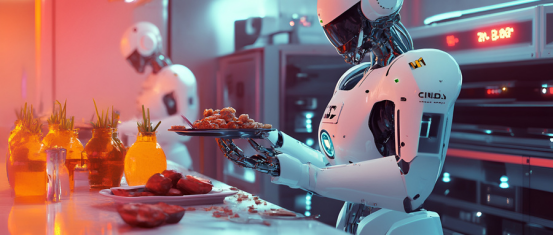In the current era of rapid technological development, food delivery robots are gradually becoming the new favorite in China's catering and related industries. Their figures frequently shuttle through restaurants, hotels, cafeterias and other venues, opening a new era of intelligent services.

Image Source:699pic.com
Taking a medium-sized restaurant as an example, if food delivery robots are introduced, it can save tens of thousands of yuan in labor expenses every year. Second, consumers' pursuit of novel dining experiences is increasingly strong. Against the backdrop of consumption upgrading, customers not only pay attention to the quality of dishes when dining, but also look forward to unique service experiences. Food delivery robots, with their highly technological appearance and intelligent operations, add a different kind of appeal to restaurants, which can significantly improve customer satisfaction and the reputation of restaurants. Furthermore, under the influence of the pandemic, the demand for contactless delivery has increased explosively. Food delivery robots can efficiently complete delivery tasks while ensuring safety. This advantage makes them stand out in special periods, and also enables more businesses to recognize their value, accelerating their popularization in the market.
In terms of application scenarios, food delivery robots have been present in multiple fields. In the catering industry, whether in hotpot restaurants, Chinese full-course meals or buffets, their busy figures can be seen. In hotpot restaurants, food delivery robots can accurately deliver ingredients and seasonings to the tables of customers, greatly improving the food serving efficiency during peak hours and reducing customer waiting time. In the hotel scenario, with the continuous advancement of the hotel chain process, especially mid-to-high-end hotels, in order to improve service quality and intelligence level, they have successively introduced food delivery robots. These robots can provide guests with 24-hour uninterrupted meal and item delivery services. Through seamless docking with the hotel management system, they can accurately respond to customer needs, greatly improving hotel operation efficiency and customer experience. In addition, in places such as school cafeterias and corporate cafeterias, food delivery robots have also begun to emerge. They can adapt to the characteristics of large passenger flow and concentrated dining time in cafeterias, quickly complete meal delivery work, and optimize the operation process of cafeterias.
Technological progress has provided a solid support for the popularization and high application of food delivery robots. Early food delivery robots had many limitations, such as only being able to travel along fixed tracks, not having obstacle avoidance functions, and being unable to flexibly cope with complex environments. But now, with the rapid development of technologies such as artificial intelligence, sensors, and navigation, these problems have been effectively solved. The current food delivery robots are generally equipped with advanced sensors, combined with technologies such as laser radar and visual SLAM, which can realize autonomous navigation, centimeter-level positioning, and real-time obstacle avoidance functions, and can flexibly shuttle even in narrow and crowded restaurant aisles.
Many enterprises have laid out in this field, and market participants cover professional robot manufacturers, technology enterprises, and catering-related enterprises that cross over into it. The products on the market are rich in variety, and the price range is also relatively wide, from 20,000 yuan to 50,000 yuan. Products in different price ranges meet the needs of different customer groups. Business models are also increasingly diversified. In addition to the traditional whole-machine direct sales model, agency sales and leasing operation models have gradually emerged. The leasing model is particularly favored by some small catering enterprises, as this model reduces the initial investment cost of enterprises, enables more businesses to try to introduce food delivery robots, and promotes their wide application in the market.
However, the food delivery robot industry is also facing some challenges in the development process. On the one hand, although technology has made remarkable progress, there are still some technical bottlenecks to be broken through, such as stability in complex environments and battery life. On the other hand, the market's awareness and acceptance of food delivery robots still need to be improved, and some businesses have doubts about their actual effects and return on investment. At the same time, industry standards and specifications are not yet perfect, and product quality is uneven, which affects the healthy development of the market to a certain extent.
Overall, food delivery robots have a broad prospect in the Chinese market. With the continuous innovation of technology, the further reduction of costs, and the improvement of market awareness, food delivery robots will be applied in more scenarios, deeply integrated into people's lives, inject strong momentum into the intelligent transformation of the catering and related industries, and become a new engine to promote the development of the industry.
- pre:The “magic box” that reshapes manufacturing
- next:How can the photovoltaic industry find opportunities in technology, policy and market?
Please click to consult us immediately or call the hotline: 4006-979-616We will solve the problems in your heart in detail。Online consultation



 Online Service
Online Service
